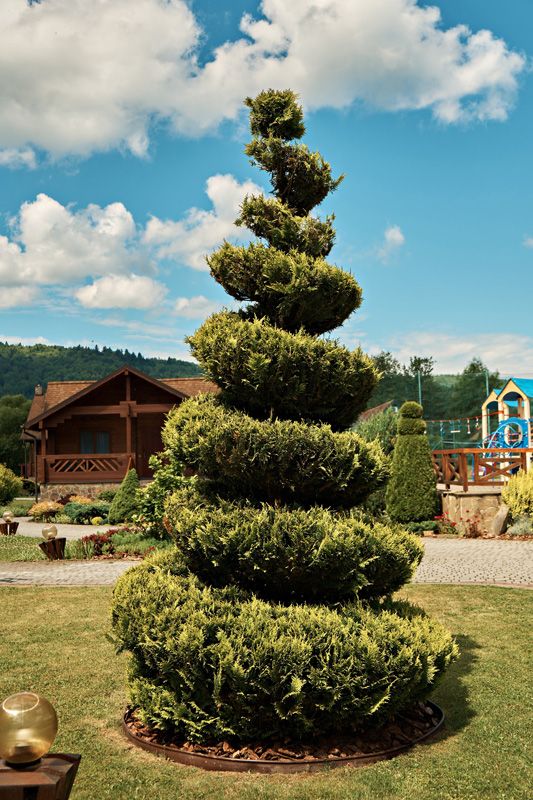
Introduction To Topiaries And Their Upkeep
Have you ever been awe-struck by a huge green sculpture of your ideal? Or maybe just basic hedges that are made out of plants? You are not the only one. Topiaries are a wonderful way of adding a classic touch to gardens by making a statement. Of course, they are not something that can be incorporated everywhere.
If you really want a traditional topiary in your garden, you could try a hedge or a border. It is not as easy as growing a simple plant. There goes a lot into learning how to make and upkeep a topiary. This basic guide will walk you through all the essential points that you should know whether or not you want a topiary.
Types of topiaries
If you believe that all topiaries are just huge, green bushes clipped into sculptures, you are wrong. It might come as a surprise to you that topiaries are also differentiated into different types.1. Traditional Topiary:
As evident from the name, traditional topiaries are crafted through the conventional method of the stem and leaves clippings. Most of the large sculptures you see in parks and gardens are made of traditional topiaries. Moreover, they do not need any support from external factors making them more feasible to grow and maintain. You can either grow bushes and shrubs from scratch and then shape them. Or you could get pre-grown plants and then shape them saving yourself time.2. Sphagnum Topiary:
A sphagnum topiary gives you the liberty of growing indoors as well as outdoors. Since sphagnum is a moss, there is no issue with its mobility too. You can use the dense moss frames and then clip them according to your requirements. They can withstand large sculptures and statues being sculpted. However small your indoor space might be, sphagnum topiaries can always be molded into your tabletop ornaments.3. Trained ivy topiary
This is by far the most convenient method of growing topiaries. You do not need any special technique, and the fact that it takes the least amount of time makes it a mass favorite option. These topiaries make use of ivy stalks and grow them around a pre-installed frame. You can choose any shape or size of the frame you want. It can be a single, straight frame or a three-dimensional frame. Place the frame wherever you want and let the ivy grow on it.How to care for Topiaries:
Full-grown, lush topiaries look breathtaking. To ensure they remain the same, you need to take good care of them. However, it depends on the type of plants that make up the topiary. There are several general guidelines that should be followed for the upkeep of a topiary, irrespective of the plant.1. Watering:
Just like regular plants, topiaries need regular watering. The amount depends on the size and stage of your topiary. If you are just starting out on growing the plant, you will be required to water when the soil seems dry. Give extra care to the low areas that are hidden under the top layers. If the topiary is fully formed, it only needs periodic misting. An internal irrigation system is also used; however, manual watering is the best way to go forward. This way, you would know exactly where and how much water is needed.2. Light conditions
Different topiary plants have different light requirements. You could choose ivy, Lavender, rosemary, or any other plant that has a thick, dense growth. For example, ivy grows best in shaded areas where the sun is not very harsh. At the same time, Lavender needs full sun for healthy growth. Therefore. It is crucial that you provide each plant its required conditions. Full-grown topiaries can survive without optimal condition for some days, after which you have to move them to their desired conditions.3. Fertilizers and Mulch
When it comes to fertilizers, they make all the difference between a lush, healthy topiary and a dry, wilting one. You could be doing everything right and still not get the aspired result just because of fertilizer. As a general rule of thumb, your topiaries need monthly fertilizing. This does not mean you should go all out on it. Make sure the fertilizer is diluted to the right extent before applying it. Otherwise, it would have far adverse effects.4. Shape
What is a topiary without a shape? This is why itis essential that you keep an eye on the shape and trim it whenever required. If it is a simple hedge, you can eyeball and maintain it. In the case of a complex sculpture or shape, a frame is required. The frame acts as a guide for the leaves to grow. Of course, this does not mean you will not have to do anything. Constant trimming and cropping are still required to keep the topiary fresh and bright. Your scissors make a huge impact on the shape and finesse. They should be razor-sharp to give a fine edge.What are the best plants to craft a Topiary?
An ideal plant to make a topiary has to be short with thick, rapid growth. It would be best if it were an evergreen species since a topiary is something that cannot grow back once it is disintegrated. With an evergreen topiary, you can enjoy the piece of art in all seasons. A few shrubs that work exceptionally well and need little maintenance are as follows:- Yew bushes
- Dwarf spruce trees
- Boxwood shrubs
- Holly shrubs
- Lavender
